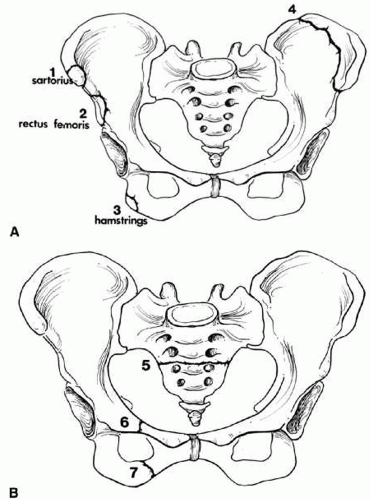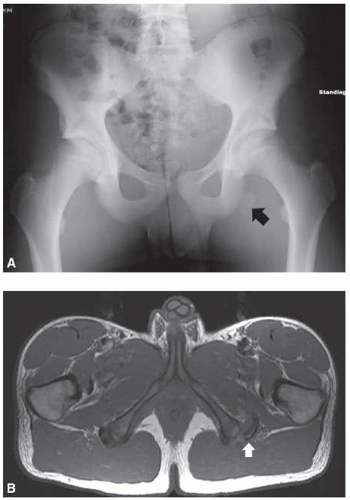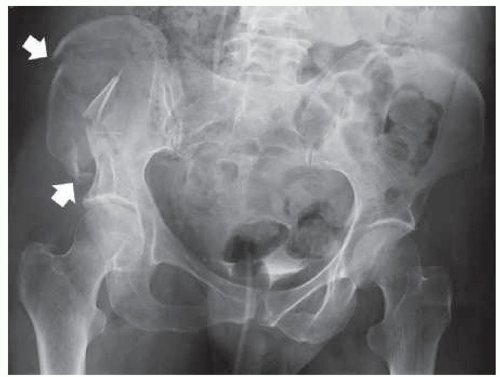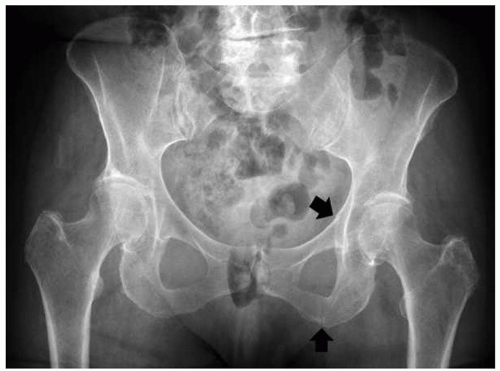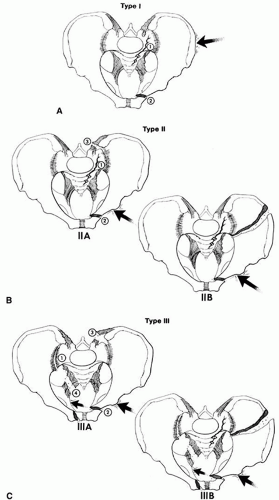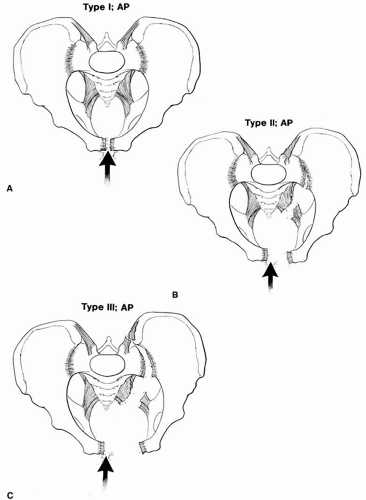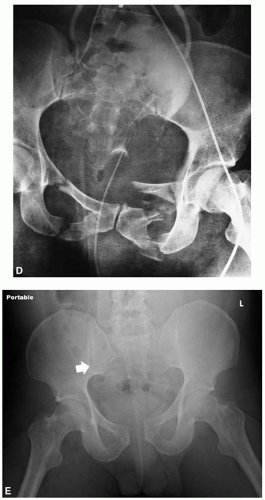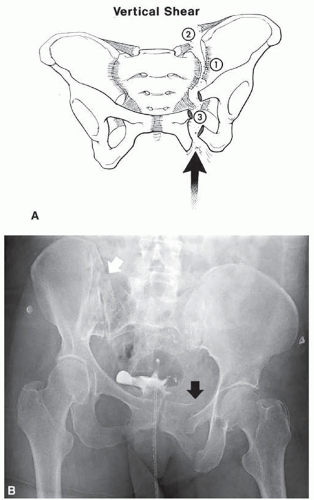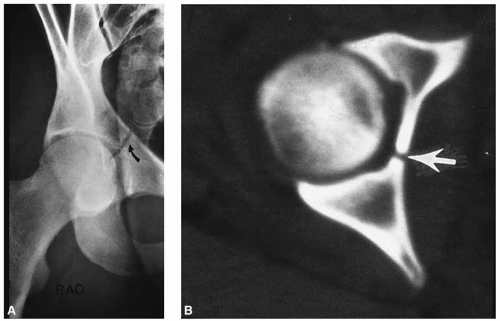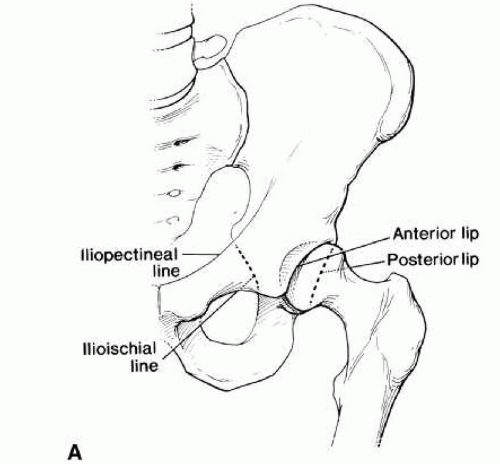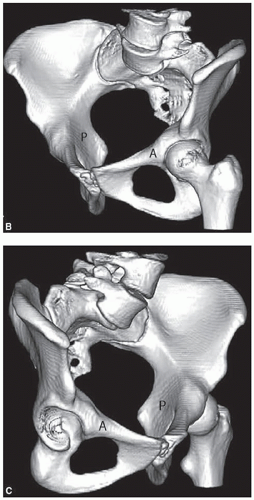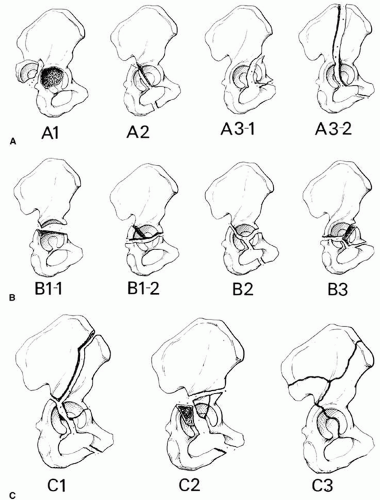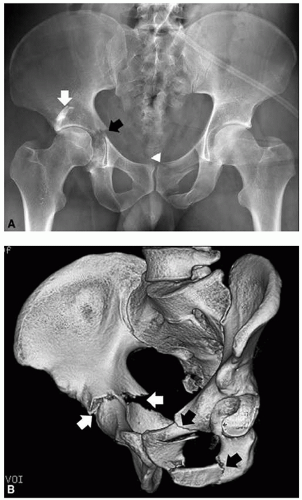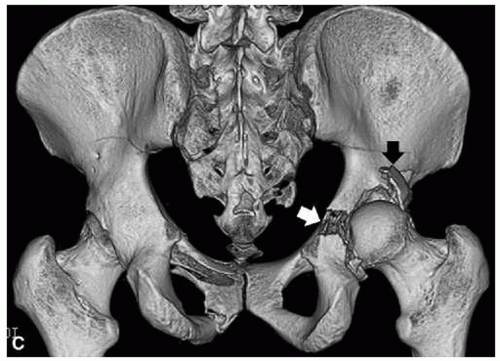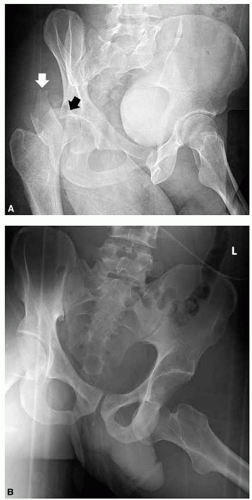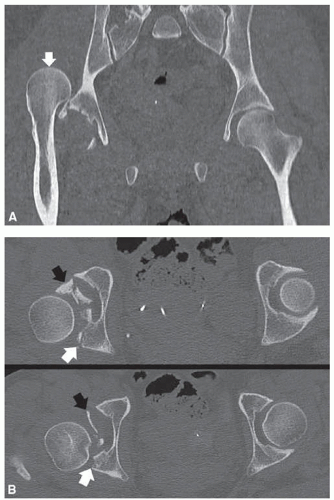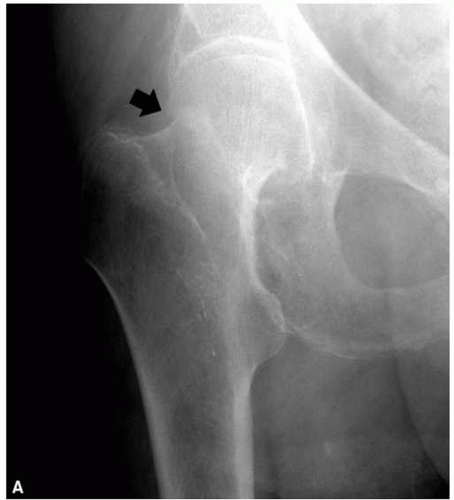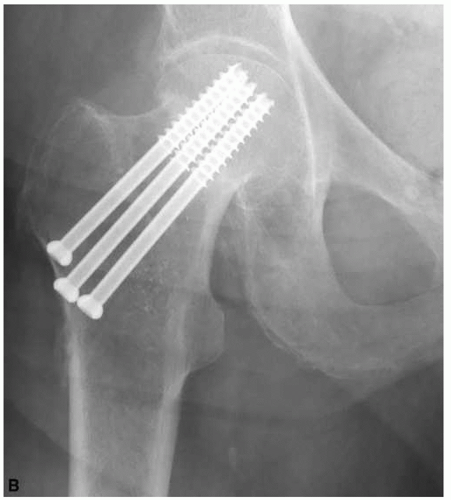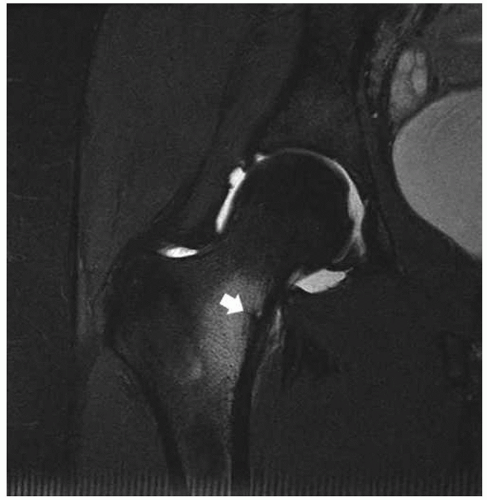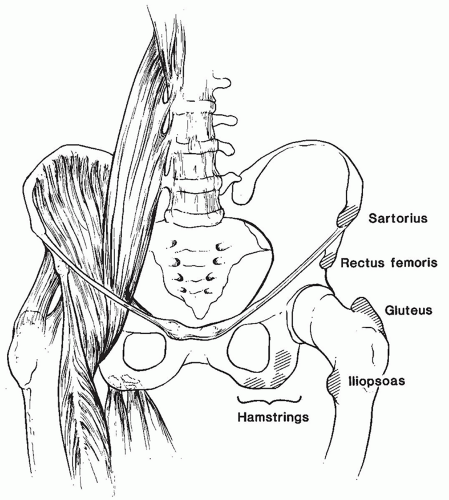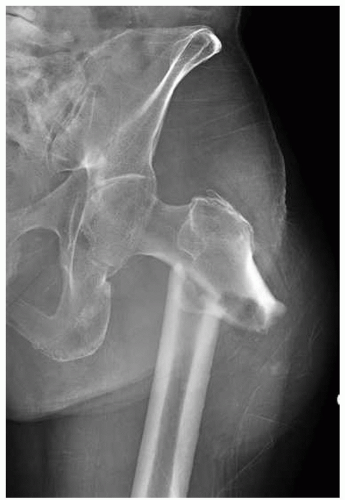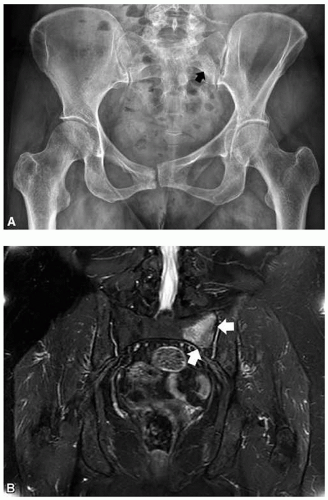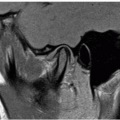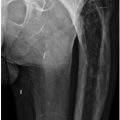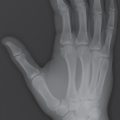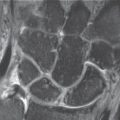Pelvis, Hips, and Thighs
Daniel E. Wessell
Jeffrey J. Peterson
Thomas H. Berquist
▪ TRAUMA: PELVIC FRACTURES—MINOR
KEY FACTS
Mechanism of injury—fall or minor trauma
Usually older age group
Fractures of individual bones or single break in pelvic ring
Minor fractures account for 25% of pelvic fractures
Common minor fractures
Avulsion fractures (Fig. 3-1)
Traumatic and apophyseal in adolescents
Pathologic in the older age group
Ischial fractures
Pubic rami fractures
Transverse sacral fractures (up to 70% missed on routine radiographs)
Complications—pain, rarely significant complications compared with complex fractures
SUGGESTED READING
Bui-Mansfield LT, Chew FS, Lenchik L, et al. Nontraumatic avulsions of the pelvis. Am J Roentgenol. 2002;178:423-427.
Singer G, Eberl R, Wegmann H, et al. Diagnosis and treatment of apophyseal injuries of the pelvis in adolescents. Semin Musculoskelet Radiol. 2014;18(5):498-504.
Young JWR, Resnick C. Fractures of the pelvis: current concepts in classification. Am J Roentgenol. 1990;155:1169-1175.
▪ TRAUMA: PELVIC FRACTURES—SINGLE BREAK IN PELVIC RING
KEY FACTS
Mechanism of injury—minor trauma
Usually nondisplaced pubic rami fractures involving one side
Account for approximately one-third of pelvic fractures
Complications—pain, local hematoma
Magnetic resonance (MR) may detect unsuspected posterior ring injuries
SUGGESTED READING
Berquist TH. Imaging of Orthopedic Trauma. 2nd ed. New York: Raven Press; 1992:207-310.
Cosker TDA, Ghandour A, Gupta SK, et al. Pelvic ramus fractures in the elderly: 50 patients studied with MRI. Acta Orthop. 2005;76:513-516.
Mucha P, Farnell MB. Analysis of pelvic fracture management. J Trauma. 1984;24:379-386.
▪ TRAUMA: PELVIC FRACTURES—COMPLEX
KEY FACTS
Mechanism of injury—high-velocity trauma, such as a motor vehicle accident
Lateral compression (41% to 72% of cases)
Anteroposterior (AP) compression (15% to 25% of cases)
Vertical shearing injuries (6% of cases)
Combined mechanisms (14% of cases)
Two or more breaks in the pelvic ring
Occur in younger age group (52% are less than 30 years of age)
Complications may be severe 100% result from multiple complications.” class=HASTIP>*
Hemorrhage
71%
Other associated fractures
65%
Genitourinary
22%
Neural injury
21%
Head injury
11%
Chest injury
11%
Abdomen injury
11%
Additional imaging, specifically computed tomography (CT), is usually required to define extent of injury
SUGGESTED READING
Failinger S, McGarrity PL. Unstable fractures of the pelvic ring. J Bone Joint Surg. 1992;74A:781-791.
Khurana B, Sheehan SE, Sodickson AD, et al. Pelvic ring fractures: what the orthopedic surgeon wants to know. Radiographics. 2014;34(5):1317-1333.
Young JWR, Resnick C. Fractures of the pelvis: current concepts and classification. Am J Roentgenol. 1990;155:1169-1175.
▪ TRAUMA: ACETABULAR FRACTURES—SIMPLE
KEY FACTS
Mechanism of injury—lower extremity trauma with force directed to the femoral head.
Fractures involve posterior acetabulum if hip flexed. Posterior dislocation may occur.
Transverse and anterior fractures occur with lateral blow to greater trochanter.
AP and Judet views may detect injury. CT with coronal and sagittal reformatting is useful to evaluate and characterize subtle fractures and the joint space involvement.
Complications—minor, or arthrosis in later years.
SUGGESTED READING
Durkee NJ, Jacobson J, Jamadar D, et al. Classification of common acetabular fractures: radiographic and CT appearances. Am J Roentgenol. 2006;187:915-925.
Letournel E. Acetabular fracture classification and management. Clin Orthop. 1980;151:81-106.
▪ TRAUMA: ACETABULAR FRACTURES—COMPLEX
KEY FACTS
Multiple fracture classification systems have been proposed.
Two-column, transverse with posterior wall involvement, and posterior wall fractures account for 66% of acetabular fractures. “T” and transverse fractures are the next two most common injury patterns. These five patterns account for 90% of acetabular fractures.
Definition of extent of articular and anterior and posterior column involvement is critical for treatment planning.
CT with reformatting in sagittal and coronal planes, or three-dimensional volume rendering, or shaded surface display is essential.
Complications are similar to complex pelvic fractures (see section on Pelvic Fractures—Complex).
SUGGESTED READING
Brandser E, Marsh JL. Acetabular fractures: easier classification with a systematic approach. Am J Roentgenol. 1998;171:1217-1228.
Saks BJ. Normal acetabular anatomy for acetabular fracture assessment: CT and plain film correlation. Radiology. 1986;159:139-145.
Scheinfeld MH, Dym AA, Spektor M, et al. Acetabular fractures: what radiologists should know and how 3D CT can aid classification. Radiographics. 2015;35:555-577.
▪ TRAUMA: FRACTURE/DISLOCATION—DISLOCATION OF THE HIP
KEY FACTS
Hip dislocations account for 5% of all skeletal dislocations.
Mechanism of injury—high-velocity trauma, usually in young adults
Posterior dislocations—10 times more common than anterior. Compressive force to foot or knee with hip flexed. Posterior acetabular fractures are common.
Anterior dislocations—forced abduction and external rotation. Femoral head and anterior acetabular fractures are common.
Up to 75% have multiple other injuries.
Most complete dislocations are obvious on the AP view of pelvis or involved hip.
CT is useful for complete evaluation of the joint space and associated fractures, especially after reduction.
SUGGESTED READING
Pfeifer K, Leslie M, Menn K et al. Imaging findings of anterior hip dislocations. Skeletal Radiol. 2017; doi:10.1007/s00256-017-2605-x
Richardson P, Young JWR, Porter D. CT detection of cortical fracture of the femoral head associated with posterior dislocation of the hip. Am J Roentgenol. 1990;155:93-94.
Rosenthal RE, Coher WL. Fracture dislocations of the hip: an epidemiologic review. J Trauma 1979;19:572-581.
▪ TRAUMA: FEMORAL NECK FRACTURES
KEY FACTS
Occur in the elderly and in females more than in males
Mechanism of injury—minimal trauma or fall
Garden classification
Type I: incomplete involving lateral cortex
Type II: complete, but undisplaced
Type III: partially displaced
Type IV: completely displaced
Some prefer undisplaced (Types I and II) and displaced (Types III and IV)
Imaging of subtle undisplaced fractures may require magnetic resonance imaging (MRI) for detection. Displaced fractures usually are obvious on routine radiographs
Complications
Mortality: 10% to 20% in the first 30 days after injury and surgery
Mortality: approximately 30% first year after injury
Avascular necrosis (AVN) is common with displaced fractures
Treatment—pin undisplaced and endoprostheses used for displaced fractures because of high incidence of AVN
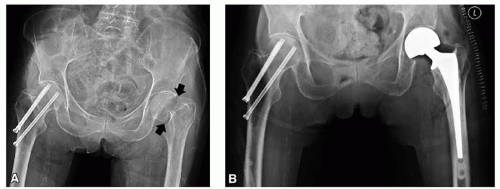 FIGURE 3-15. (A) Displaced femoral neck fracture (black arrows). (B) Treated with bipolar hemiarthroplasty. Note the prior right femoral neck fracture treated by percutaneous pinning. |
SUGGESTED READING
Berquist TH. Imaging Atlas of Orthopedic Appliances and Prostheses. New York: Raven Press; 1995:217-352.
Garden RS. Stability and union of subcapital fractures of the femur. J Bone Joint Surg. 1964;64B:630-712.
Morgan CG, Wenn RT, Sikand M, et al. Early mortality after hip fracture: is delay before surgery important. J Bone Joint Surg. 2005;87A:483-490.
Sheehan SE, Shyu JY, Weaver MJ, et al. Proximal femoral fractures: what the orthopedic surgeon wants to know Radiographics. 2015;35:1563-1584.
▪ TRAUMA: TROCHANTERIC FRACTURES
KEY FACTS
Three types of fracture: avulsion, intertrochanteric, and subtrochanteric
Intertrochanteric fractures
Most common in elderly because of falls
Extracapsular; comminution of fracture with detachment of trochanters common
Significant mortality (18% to 30%) in year of injury
Subtrochanteric fractures
More common in younger patients with high-velocity trauma
Can be associated with chronic bisphosphonate treatment
Reduction more difficult to maintain than intertrochanteric fractures
Avulsion fractures
Caused by abrupt muscle contraction (Fig. 3-17)
Occur in active athletes
Greater trochanteric avulsions also seen in elderly patients
Routine radiographs usually are diagnostic
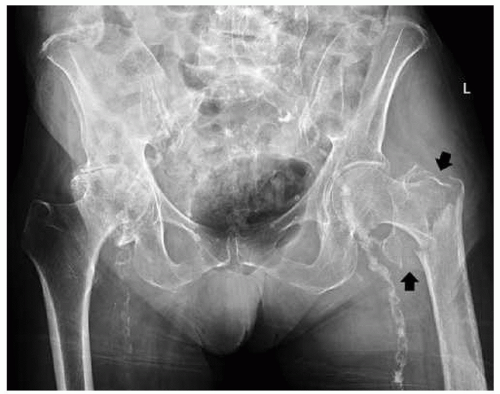 FIGURE 3-18. Anteroposterior (AP) pelvic radiograph of a comminuted intertrochanteric femur fracture (black arrows) angular deformity (coxa vara deformity). |
SUGGESTED READING
Jensen JS. Classification of trochanteric fractures. Acta Orthop Scand. 1980;51:803-810.
Lorich DG, Geller DS, Nelson JH. Osteoporotic pertrochanteric hip fractures. J Bone Joint Surg. 2004;86A:398-410.
Porrino JA Jr, Kohl CA, Taljanovic M, et al. Diagnosis of proximal femoral insufficiency fractures in patients receiving bisphosphonate therapy. Am J Roentgenol. 2010;194:1061-1064.
▪ TRAUMA: INSUFFICIENCY FRACTURES
KEY FACTS
Insufficiency fractures occur because of normal stress on bone with abnormal elastic resistance.
Insufficiency fractures most commonly involve the sacrum, pubic rami, and supra-acetabular regions and femoral necks.
Most insufficiency fractures occur in elderly osteopenic patients or patients on steroid therapy.
Patients present with back, hip, or groin pain.
Image features
Radiographs: Bone sclerosis or condensation, typically linear.
Radionuclide scans: Increased tracer in area of fracture. Bilateral sacral fractures give “H” appearance (Honda sign).
MRI: Marrow edema pattern with or without visible fracture line.
CT: Fracture lines clearly defined.
SUGGESTED READING
Cabarrus MC, Ambekar A, Lu Y, et al. MRI and CT of insufficiency fractures of the pelvis and the proximal femur. Am J Roentgenol. 2008;191:995-1001.
Pek WCG, Khong PL, Yur Y, et al. Imaging of pelvic insufficiency fractures. Radiographics. 1996;16:335-348.
▪ TRAUMA: SOFT TISSUE TRAUMA
KEY FACTS
Soft tissue injuries to the pelvis, hips, and thighs may include
Muscle/tendon injuries
Ligament injuries
Neurovascular injuries
Acetabular labral tears
Bursitis
Snapping tendon syndromes
Greater trochanteric pain syndrome
Imaging approaches vary with suspected clinical condition
Condition | Imaging Approach |
Muscle/tendon injury | MRI |
Ligament injury | MRI or MR arthrography of the hip for intra-articular hip pathology |
Neurovascular injury | MRI |
Acetabular labral tears | MR arthrography of the hip |
Bursitis | Ultrasound or MRI |
Snapping tendon syndrome | Tendon injection with motion studies, ultrasound |
MR, magnetic resonance; MRI, magnetic resonance imaging. | |
SUGGESTED READING
Cvtanic O, Henzie G, Skezas DS, et al. MRI diagnosis of tears in the abductor tendons (gluteus medius and gluteus minimus). Am J Roentgenol. 2004;182:137-143.
Czermy C, Hofmann S, Nenhold A, et al. Lesions of the acetabular labrum: accuracy of MR imaging and MR arthrography in detection and staging. Radiology. 1999;220:225-230.
DeSmet AA, Fisher DR, Heiner JP, et al. Magnetic resonance imaging of muscle tears. Skeletal Radiol. 1990;19:283-286.
Khan W, Zoga AC, Meyers WC. Magnetic resonance imaging of athletic pubalgia and the sports hernia: current understanding and practice. Magn Reson Imaging Clin N Am. 2013;21:97-110.
Lonner JH, Van Kleunen JP. Spontaneous rupture of the gluteus medius and minimus tendons. Am J Orthop. 2002;31:579-581.
Rubin DA. Imaging diagnosis and prognostication of hamstring injuries. Am J Roentgenol. 2012;199:525-533.
▪ TRAUMA: SOFT TISSUE TRAUMA—MUSCLE/TENDON TEARS
KEY FACTS
Muscle/tendon tears are common in athletes and patients engaged in exercise programs.
Underlying disorders (diabetes mellitus, steroid therapy, connective tissue diseases, and renal failure) may also lead to myotendinous injuries.
Categories of injury
Grade 1 strain: a few fibers torn
Grade 2 strain: approximately 50% of fibers torn
Grade 3 strain: complete tear
Hematoma
Myositis ossificans
Muscles involved include the hamstrings, adductors, gluteal, iliopsoas, and abdominal muscles.
Radiographs or CT is useful for avulsion injuries or myositis ossificans.
MRI is superior for the detection and staging of injuries.
 FIGURE 3-22. Axial (A) and sagittal (B) T2-weighted fat-suppressed images of a Grade 2 strain of the rectus femoris. (A) The muscle edema is centered at the myotendinous junction (white arrow). (B) Feathery edema extends through the muscle fibers (black arrows) with a small anterior hematoma (white arrow).
Stay updated, free articles. Join our Telegram channel
Full access? Get Clinical Tree
 Get Clinical Tree app for offline access
Get Clinical Tree app for offline access

|
